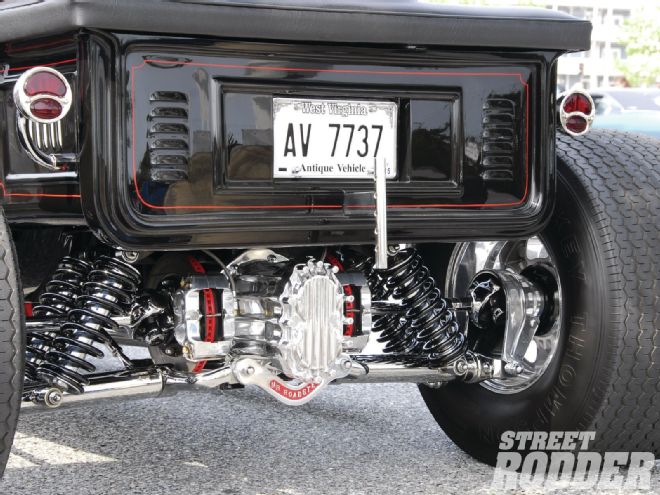
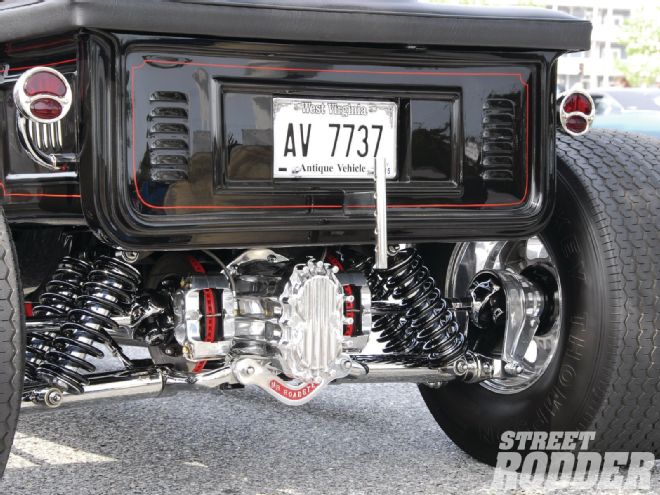 When Jag independent rearends started showing up in the late ’60s and early ’70s there wasn’t much that was considered cooler, especially when they were fully chromed and hanging out in the breeze. They still look impressive, as this T-bucket proves. Photo by Chuck Vranas.
When Jag independent rearends started showing up in the late ’60s and early ’70s there wasn’t much that was considered cooler, especially when they were fully chromed and hanging out in the breeze. They still look impressive, as this T-bucket proves. Photo by Chuck Vranas.
Independent rear suspension (IRS) has been around for a long time and has been used under everything from every Volkswagen Beetle ever made to the latest and greatest supercars.
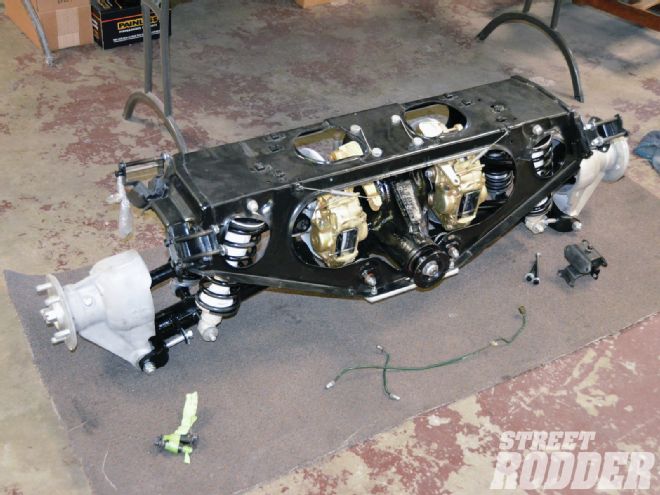 This is a Jag IRS in its natural habitat, a big sheetmetal cradle. The legendary Kent Fuller installed this unit under Tom Medley’s ’40 Ford. After a fire that nearly destroyed the car, another legend, Curt Hamilton, rebuilt it.
This is a Jag IRS in its natural habitat, a big sheetmetal cradle. The legendary Kent Fuller installed this unit under Tom Medley’s ’40 Ford. After a fire that nearly destroyed the car, another legend, Curt Hamilton, rebuilt it.
IRS offers a number of advantages over solid, or live axles; chief among them is lower unsprung weight. Sprung weight is all that is supported by the springs, anything that isn’t supported by the suspension (like the wheels and tires) is unsprung weight and parts that are both, a driveshaft for example, are half and half. As unsprung weight increases, the harder it is for the springs and shocks to control the movement of the wheel and tire assembly. In simple terms, when a tire encounters irregularities in the road the suspension allows it to move up or down, the lighter the unsprung components are, the less mass they have, and the easier it is for them to change directions and keep the tires in contact with the road.
One of the best arguments for IRS under a street rod is the ratio of sprung to unsprung weight. Street rods are generally light, at least in terms of sprung components, but they often have a relatively heavy rearend, big brakes, and large wheels and tires, which leads to relatively high unsprung to sprung weight ratio. That out-of-balance relationship will impact ride quality, but even more importantly stability is compromised and the result is a car that skips and chatters over uneven surfaces. The name of the game is to keep the rubber in contact with the road and for that IRS can’t be beat.
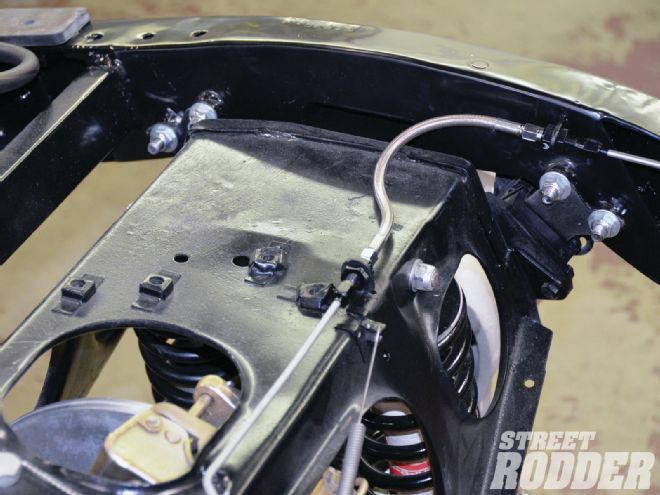 As in the stock Jag application, the cradle attaches to the ’40 frame at four points with rubber mounts. Only minor modifications to the framerails were required for the installation.
As in the stock Jag application, the cradle attaches to the ’40 frame at four points with rubber mounts. Only minor modifications to the framerails were required for the installation.
If IRS systems have a shortcoming in performance it’s with hard acceleration from a standing start. In most cases antisquat, the design element that keeps the rear of the car from dropping under acceleration, is hard to engineer into these systems. But while an IRS won’t “hook up” as hard as a live axle under hard acceleration that’s a small price to pay for the other advantages, unless you drag race.
There are a number of IRS designs that have been used over the years, the primary difference is the method used to locate the hubs and maintain/adjust rear-wheel alignment. The singe trailing arm style, like those found under the Jaguar and early Corvette, use locators that attach to the frame and the outboard hubs to locate the wheels fore and aft. These rearends also had a lower link connecting the hubs to the centersection and used the drive axles as upper links, all of which acted as lateral locators. The Corvette used shims at the front of the trailing arm to set toe and eccentrics on the lower control rods to set camber. In stock form the Jaguar uses an eccentric pin in the bottom pivot to adjust toe and shims between the inner U-joints and the differential flanges to adjust camber. A variation on the trailing arm uses multiple links, what are in effect four-bars, to locate the wheel hubs fore and aft, lateral location is done by the driveshafts and a lower link, which can also be used to adjust camber; additional links are used to maintain alignment and allow for toe adjustments.
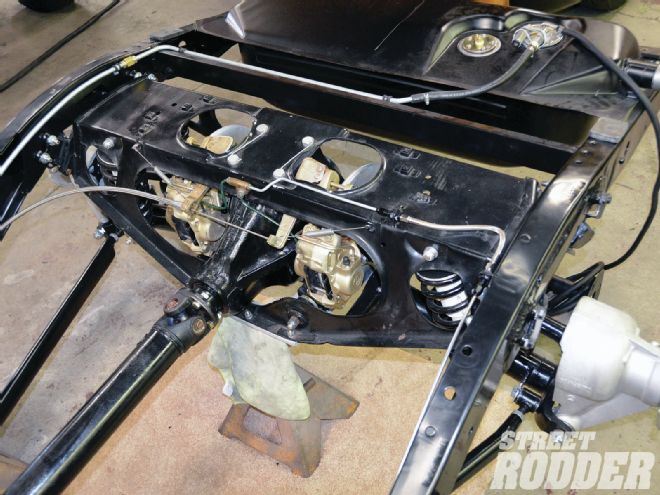 Certainly not zoomy looking when caged, it doesn’t much matter because it can’t be seen under Medley’s ’40, but it sure rides nice.
Certainly not zoomy looking when caged, it doesn’t much matter because it can’t be seen under Medley’s ’40, but it sure rides nice.
Wishbone IRS is similar to independent front suspension in that upper and lower control arms are used. The hubs attach to the control arms with ball joints and links from the hubs are used to maintain/adjust toe while camber is altered by eccentrics, shims, or threaded ends on the control arms.
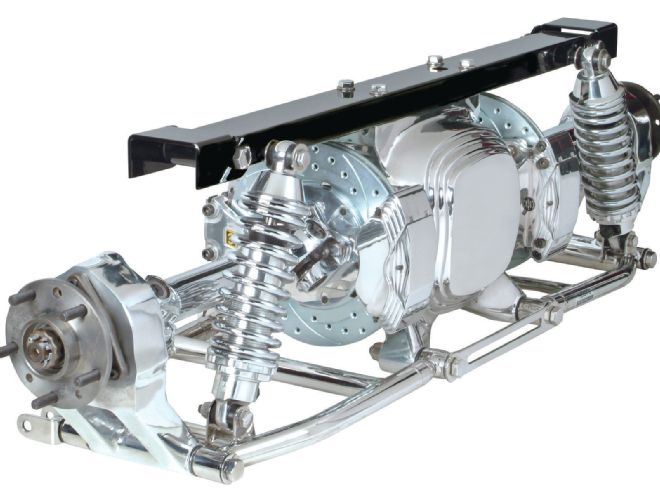 Heidts Hot Rod Shop offers a variety of IRS systems and a long list of options, including a chrome and polish package for maximum bling. Here the centersection is a Ford 9-inch.
Heidts Hot Rod Shop offers a variety of IRS systems and a long list of options, including a chrome and polish package for maximum bling. Here the centersection is a Ford 9-inch.
IRS systems under street rods are nothing new. Two San Jose Roadster Club members, Les Erben and Joe Cardoza, stuffed Jag rearends under Model A roadster pickups in the later ‘60s and the rest is history; soon Corvette IRS began showing up as well.
While the Jag and the various Vette rearends are still used today there are some great new options. Several of the top chassis and suspension manufacturers build complete IRS system. They’re well thought out, available in a variety of widths with an assortment of brake packages and options. For those considering an IRS for a street rod, here are some of the best.
Curt Hamilton has been around street rodding for a long while; he was the man behind the Cal Automotive fiberglass T-bucket body in the ’70s. Today, among the assortment of things he does in his one-man shop, he rebuilds Jag IRS units. With his stockpile of unique, hard-to-find parts and his years of experience, Hamilton can make a Jag rearend better than new.
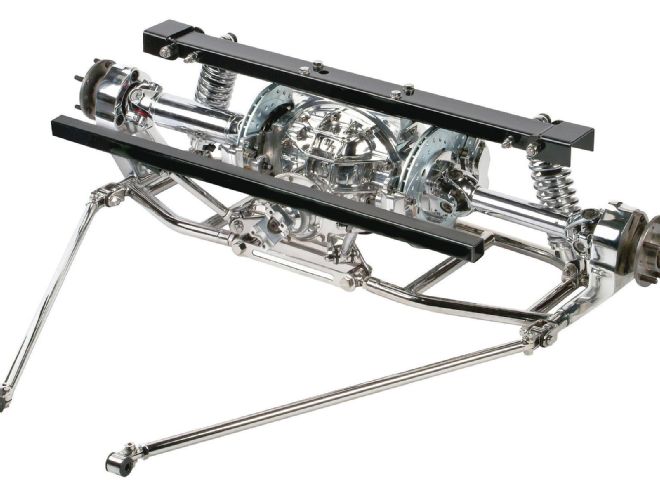 Heidts center crossmembers are custom sized to fit between the rear framerails. After the mounting tabs are welded in, everything else bolts on.
Heidts center crossmembers are custom sized to fit between the rear framerails. After the mounting tabs are welded in, everything else bolts on.
Recently Hamilton worked his magic on the Jag IRS that was under Tom Medley’s fire-ravaged ’40 Ford coupe. While Medley’s Jag is in the stock cage, Hamilton does offer a much more refined, better-looking, and easy-to-install mounting system fabricated from tubing. Give him a call for more information.
Heidts Hot Rod Shop is one of the leaders in independent suspension for street rods. They now offer seven bolt-in or weld-in high-performance IRS systems. Their Super Ride IRS features inboard Wilwood brakes, fully adjustable coilover shocks, forward strut bars, full pinion support, massive control arms, parking brakes, and a bulletproof 9-inch centersection available in almost any gear ratio.
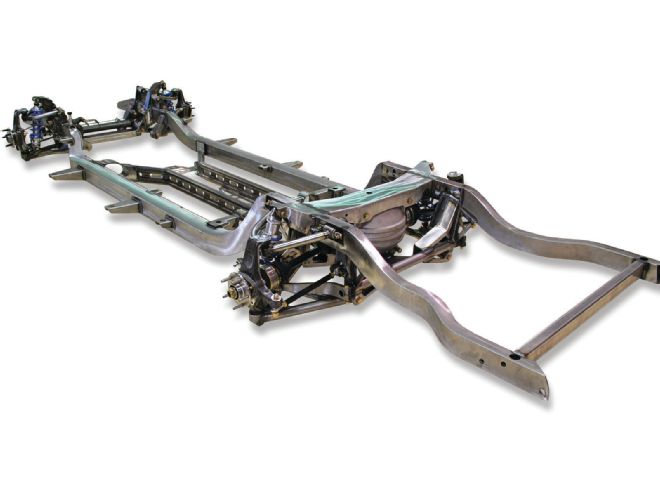 Kugel Komponents offers a number of options, including a Winters quick-change centersection and billet Wilwood calipers, as shown here.
Kugel Komponents offers a number of options, including a Winters quick-change centersection and billet Wilwood calipers, as shown here.
Kugel Komponents was the first to market a custom IRS. Their kits come fully assembled with a cast-iron 9-inch Ford centersection, Aldan coilovers, Wilwood brakes, and Corvette bearing assemblies. Halfshafts, control arms, risers, and rearend covers are custom Kugel pieces.
To ensure a perfect fit, custom crossmembers are built for specific applications and a long list of extras are available. Centersections can be cast iron or aluminum, open or posi, or even a quick-change. Kugel recommends an upgrade to two coilovers per side for heavy cars and custom-rate Eibach springs. Sway bars are also available.
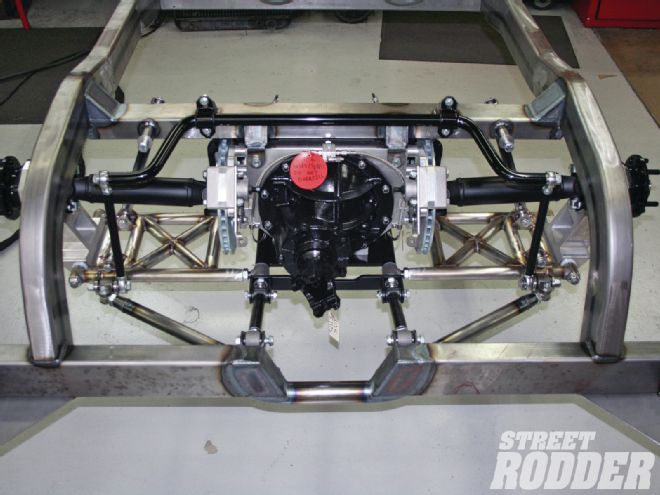 This Kugel IRS uses a Ford 9-inch centersection with inboard brakes. Standard tread widths are from 52 to 62 inches in 1/2-inch increments.
This Kugel IRS uses a Ford 9-inch centersection with inboard brakes. Standard tread widths are from 52 to 62 inches in 1/2-inch increments.
The Roadster Shop recently introduced their new IRS. It features outboard brakes for easy rotor and pad changes and Corvette C6 spindles, hubs, and sway bar endlinks for easy maintenance, OEM quality, and availability. Right- and left-hand Aurora rod ends connected by a hex shaft make toe changes simple; caster and camber changes and adjustments are made by adding or removing shims.
Ease of maintenance was designed into the system—the unique bracketry makes removal of the third member simple and the dropout lower support bracket allows for easy removal of entire rearend housing. To simplify suspension tuning, the shocks and springs are easily removable and the splined sway bar simplifies adjustments.
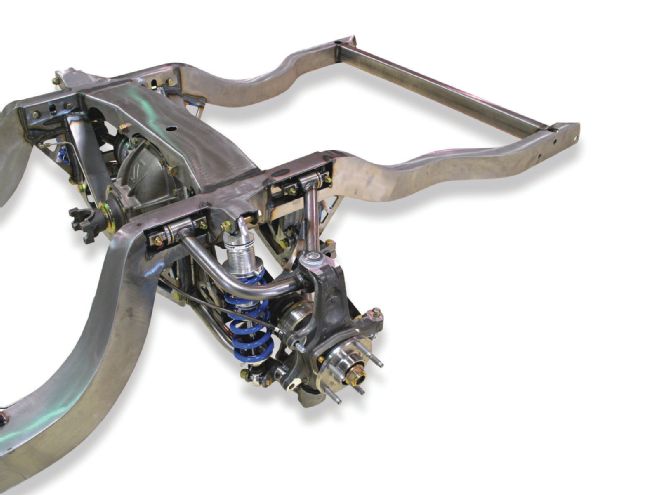 New from the Roadster Shop is the new Fast Track IRS with upper and lower A-frames.
New from the Roadster Shop is the new Fast Track IRS with upper and lower A-frames.
Scott’s Hot Rods and Customs provides quick-change centersections from Speedway Engineering or Winters with the customer’s choice of gear ratios. All IRS kits come with inboard 12-inch cross-drilled and slotted Wilwood brakes with four-piston calipers and billet Aldan coilovers. The hubs are 6061 billet, while the control arms are DOM mild steel on the base kit.
A long list of options are available, control arms can be upgraded to solid stainless pieces, and pretty much everything else can be ordered either fully polished or chromed. Coilovers can be twin or quad and ShockWave air springs are also available.
 Brakes on the Roadster Shop IRS are mounted outboard, spindles and hubs are Corvette C-6.
Brakes on the Roadster Shop IRS are mounted outboard, spindles and hubs are Corvette C-6.
Team 321 builds independent rear suspensions for everything from mid-engine applications to Cobras and street rods. The A-arm–style suspension features inboard-mounted coilover shocks along with a readily available and affordable 8.8-inch Ford centersection.
A wide range of track widths are available with either Ford Chrysler 5-on-4.5-inch or Chevy 5-on-4.75-inch bolt patterns. Spring rates and shock valving are available to tailor ride quality to individual needs along with brake options, such as Wilwood calipers and drilled and slotted rotors.
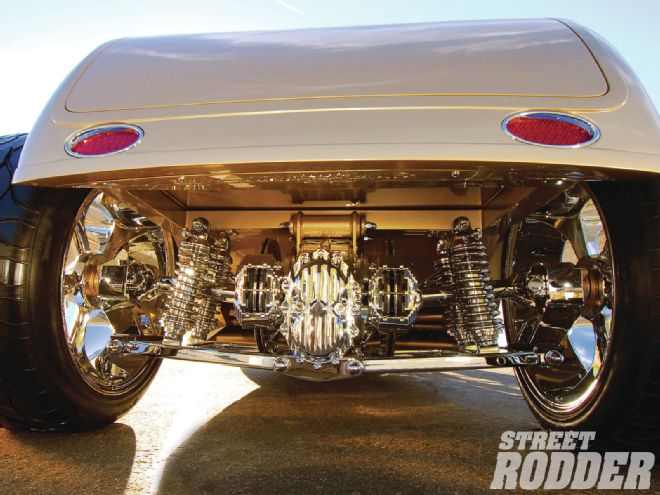 IRS kits from Scott’s are available in a variety of configurations. This example uses quadruple coilovers; air suspension is also offered.
IRS kits from Scott’s are available in a variety of configurations. This example uses quadruple coilovers; air suspension is also offered.
So is an IRS worth the investment or are they just eye candy? That depends on your viewpoint. In the ’80s Trans Am racers were allowed to use a solid rear axle or an IRS. Surprisingly, on smooth tracks lap times were virtually the same, there was no real performance advantage to an IRS. However in the real world, with roads that range from smooth to washboard and expansion strips, dips, bumps, and potholes are part of the driving experience and an IRS will ride and handle better than a solid axle, hands down. And if that’s not a good enough reason to consider an IRS, wiggly rears really do look cool.